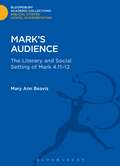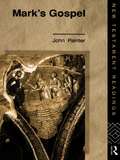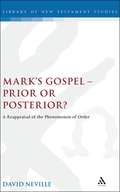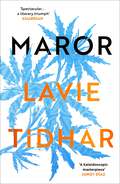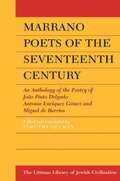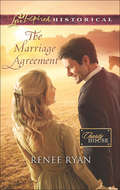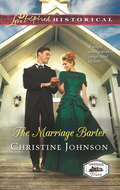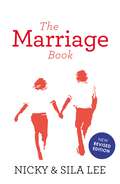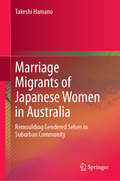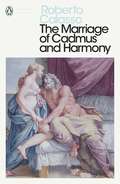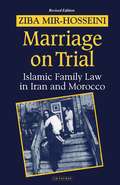- Table View
- List View
Marketplace of the Gods: How Economics Explains Religion
by Larry WithamTwo centuries after Adam Smith illuminated the workings of the marketplace, a new movement among economists and social scientists is expanding his insights into a groundbreaking "economics of religion." Using cutting edge ideas from the behavioral sciences, and a deep knowledge of religious history, this new approach is making sense not only of past beliefs, but of religion today. In Marketplace of the Gods, award-winning journalist Larry Witham tells the inside story of this expanding "economic approach" to religion, the puzzles it tries to solve, the controversies it has stirred, and the people who are making it happen. He shows that the economic approach, while evoking images of stock markets or accounting ledgers, actually begins with a simple idea about human beings as rational actors, judging costs and benefits in life. Every life has limits, so human experience is a series of trade-offs, balancing resources to make choices for the best possible benefits. As the economics of religion shows, this model can be applied to the rich story of the human race and its gods. Beginning with the individual, the choices in religion shape households, groups, movements, and entire "religious economies" of nations. On the one hand, this mixing of the profane and the sacred, the economic and the religious, is an exciting exchange of ideas between economics, sociology, psychology, history, and theology. On the other, it has spurred a lively protest. Indeed, for some, the economic approach seems to transform our good angels into grubby consumers. As Witham shows, however, the economic approach to religion has insights for everyone, believers and skeptics alike. He illuminates this approach in a volume rich with ideas, history, contemporary events, and the insights of some of our sharpest modern-day thinkers.
Marketplace of the Gods: How Economics Explains Religion
by Larry WithamTwo centuries after Adam Smith illuminated the workings of the marketplace, a new movement among economists and social scientists is expanding his insights into a groundbreaking "economics of religion." Using cutting edge ideas from the behavioral sciences, and a deep knowledge of religious history, this new approach is making sense not only of past beliefs, but of religion today. In Marketplace of the Gods, award-winning journalist Larry Witham tells the inside story of this expanding "economic approach" to religion, the puzzles it tries to solve, the controversies it has stirred, and the people who are making it happen. He shows that the economic approach, while evoking images of stock markets or accounting ledgers, actually begins with a simple idea about human beings as rational actors, judging costs and benefits in life. Every life has limits, so human experience is a series of trade-offs, balancing resources to make choices for the best possible benefits. As the economics of religion shows, this model can be applied to the rich story of the human race and its gods. Beginning with the individual, the choices in religion shape households, groups, movements, and entire "religious economies" of nations. On the one hand, this mixing of the profane and the sacred, the economic and the religious, is an exciting exchange of ideas between economics, sociology, psychology, history, and theology. On the other, it has spurred a lively protest. Indeed, for some, the economic approach seems to transform our good angels into grubby consumers. As Witham shows, however, the economic approach to religion has insights for everyone, believers and skeptics alike. He illuminates this approach in a volume rich with ideas, history, contemporary events, and the insights of some of our sharpest modern-day thinkers.
Markets and Ideology in the City of London
by David LazarMarkets and Ideology in the City of London is the first fieldwork-based sociological study of how participants in City of London financial markets view the markets in which they work and the market mechanism in general. But it is more than a narrow study of financial market participants because it is also an empirical investigation into how ideologies function and it develops a critique of pro-market ideologies such as 'Thatcherism'. Finally, it is one of a small number of sociological studies into the privileged world of high earners and the wealthy - sociologists too frequently study the powerless and the 'deviant' or 'marginal' groups.
Mark's Audience: The Literary and Social Setting of Mark 4.11-12 (Bloomsbury Academic Collections: Biblical Studies)
by Mary Ann BeavisMark 4.11-12, the 'parable theory' passage, has probably been commented upon more often than any other section of Mark's Gospel. The saying has usually been interpreted as an authentic utterance of Jesus, which was subsequently misunderstood and misinterpreted by early Christians - including the evangelist Mark. The precise meaning of the mystery logion in the ministry of Jesus is notoriously elusive, since we have no information about the context in which it was spoken, or about the audience to which it was addressed. Much more, however, can be known about the interpretative context of the logion in Mark, since it is surrounded by passages that seem to echo the mystery saying. This study examines the complex web of literary relationships between Mark 4.11-12 and the Gospel as a whole. Dr Beavis's fresh interpretation is unusual in that she undertakes to interpret the Gospel of Mark, as far as possible, from the point of view of its 'historical' readers/audience. Chapters 1 and 2 of the book attempt to describe the 'community' for which the Gospel was written, and in the rest of the book, this socio-cultural setting is used to investigate the meaning of the mystery saying for the original readers/hearers of Mark.
Mark's Gospel
by John PainterMark's 'biography' of Jesus is the earliest of the four gospels, and influenced them all. The distinctive feature of this biography is the quality of 'good news', which presupposes a world dominated by the forces of evil.John Painter shows how the rhetorical and dramatic shaping of the book emphasises the conflict of good and evil at many levels - between Jesus and the Jewish authorities, Jesus and the Roman authorities, and the conflict of values within the disciples themselves. These matters of content are integral to this original approach to Mark's theodicy, while the stylistic issue raises the question of Mark's intended readership.John Painter's succinct yet thorough treatment of Mark's gospel opens up not only these rhetorical issues, but the social context of the gospel, which Painter argues to be that of the Pauline mission to the nations.
Mark's Gospel
by John PainterMark's 'biography' of Jesus is the earliest of the four gospels, and influenced them all. The distinctive feature of this biography is the quality of 'good news', which presupposes a world dominated by the forces of evil.John Painter shows how the rhetorical and dramatic shaping of the book emphasises the conflict of good and evil at many levels - between Jesus and the Jewish authorities, Jesus and the Roman authorities, and the conflict of values within the disciples themselves. These matters of content are integral to this original approach to Mark's theodicy, while the stylistic issue raises the question of Mark's intended readership.John Painter's succinct yet thorough treatment of Mark's gospel opens up not only these rhetorical issues, but the social context of the gospel, which Painter argues to be that of the Pauline mission to the nations.
Mark's Gospel--Prior or Posterior?: A Reappraisal of the Phenomenon of Order (The Library of New Testament Studies #222)
by David NevilleThe similarities and difference of arrangement and order of episodes in the gospels of Mark, Matthew and Luke have always been one of the major critera for resolving the Synoptic Problem. How important, and how reliable are arguments based on such considerations, and where might they lead? Here Neville reviews these issues in detail, explaining the significance of his conclusions for understanding the literary relationships among the three Synoptics gospels, and particularly for the competing theories of Markan priority (the standard two-source hypothesis) and Markan posteriority (the Griesbach hypothesis).
Marks of an Absolute Witch: Evidentiary Dilemmas in Early Modern England
by Orna Alyagon DarrThis work explores the social foundation of evidence law in a specific historical social and cultural context - the debate concerning the proof of the crime of witchcraft in early modern England. In this period the question of how to prove the crime of witchcraft was the centre of a public debate and even those who strongly believed in the reality of witchcraft had considerable concerns regarding its proof. In a typical witchcraft crime there were no eyewitnesses, and since torture was not a standard measure in English criminal trials, confessions could not be easily obtained. The scarcity of evidence left the fact-finders with a pressing dilemma. On the one hand, using the standard evidentiary methods might have jeopardized any chance of prosecuting and convicting extremely dangerous criminals. On the other hand, lowering the evidentiary standards might have led to the conviction of innocent people. Based on the analysis of 157 primary sources, the book presents a picture of a diverse society whose members tried to influence evidentiary techniques to achieve their distinct goals and to bolster their social standing. In so doing this book further uncovers the interplay between the struggle with the evidentiary dilemma and social characteristics (such as class, position along the centre/periphery axis and the professional affiliation) of the participants in the debate. In particular, attention is focused on the professions of law, clergy and medicine. This book finds clear affinity between the professional affiliation and the evidentiary positions of the participants in the debate, demonstrating how the diverse social players and groups employed evidentiary strategies as a resource, to mobilize their interests. The witchcraft debate took place within the formative era of modern evidence law, and the book highlights the mutual influences between the witch trials and major legal developments.
Marks of an Absolute Witch: Evidentiary Dilemmas in Early Modern England
by Orna Alyagon DarrThis work explores the social foundation of evidence law in a specific historical social and cultural context - the debate concerning the proof of the crime of witchcraft in early modern England. In this period the question of how to prove the crime of witchcraft was the centre of a public debate and even those who strongly believed in the reality of witchcraft had considerable concerns regarding its proof. In a typical witchcraft crime there were no eyewitnesses, and since torture was not a standard measure in English criminal trials, confessions could not be easily obtained. The scarcity of evidence left the fact-finders with a pressing dilemma. On the one hand, using the standard evidentiary methods might have jeopardized any chance of prosecuting and convicting extremely dangerous criminals. On the other hand, lowering the evidentiary standards might have led to the conviction of innocent people. Based on the analysis of 157 primary sources, the book presents a picture of a diverse society whose members tried to influence evidentiary techniques to achieve their distinct goals and to bolster their social standing. In so doing this book further uncovers the interplay between the struggle with the evidentiary dilemma and social characteristics (such as class, position along the centre/periphery axis and the professional affiliation) of the participants in the debate. In particular, attention is focused on the professions of law, clergy and medicine. This book finds clear affinity between the professional affiliation and the evidentiary positions of the participants in the debate, demonstrating how the diverse social players and groups employed evidentiary strategies as a resource, to mobilize their interests. The witchcraft debate took place within the formative era of modern evidence law, and the book highlights the mutual influences between the witch trials and major legal developments.
Marks of His Wounds: Gender Politics and Bodily Resurrection
by Beth Felker JonesIt is a central tenet of Christian theology that we will be resurrected in our bodies at the last day. But we have been conditioned, writes Beth Felker Jones, to think of salvation as being about anything but the body. We think that what God wants for us has to do with our thoughts, our hearts, or our interior relationships. In popular piety and academic theology alike, strong spiritualizing tendencies influence our perception of the body. Historically, some theologians have denigrated the body as an obstacle to sanctification. This notion is deeply problematic for feminist ethics, which centers on embodiment. Jones's purpose is to devise a theology of the body that is compatible with feminist politics. Human creatures must be understood as psychosomatic unities, she says, on analogy with the union of Christ's human and divine natures. She offers close readings of Augustine and Calvin to find a better way of speaking about body and soul that is consonant with the doctrine of bodily resurrection. She addresses several important questions: What does human psychosomatic unity imply for the theological conceptualization of embodied difference, especially gendered difference? How does embodied hope transform our present bodily practices? How does God's momentous "yes" to the body, in the Incarnation, both judge and destroy the corrupt ways we have thought, produced, constructed, and even broken bodies in our culture, especially bodies marked by race and gender? Jones's book articulates a theology of human embodiment in light of resurrection doctrine and feminist political concerns. Through reading Augustine and Calvin, she points to resources for understanding the body in a way that coheres with the doctrine of the resurrection of the flesh. Jones proposes a grammar in which human psychosomatic unity becomes the conceptual basis for sanctification. Using gender as an illustration, she interrogates the difference resurrection doctrine makes for holiness. Because death has been overcome in Christ's resurrected body, human embodiment can bear witness to the Triune God. The bodily resurrection makes sense of our bodies, of what they are and what they are for.
Maror
by Lavie Tidhar'A masterpiece of the sacred and the profane... A literary triumph.' Jake Arnott, GuardianHow do you build a nation?It takes statesmen and soldiers, farmers and factory workers, of course. But it also takes thieves, prostitutes and policemen.Nation-building demands sacrifice. And one man knows exactly where those bodies are buried: Cohen, a man who loves his country. A reasonable man for unreasonable times.A car bomb in the back streets of Tel Aviv. A diamond robbery in Haifa. Civil war in Lebanon. Rebel fighters in the Colombian jungle. A double murder in Los Angeles.How do they all connect? Only Cohen knows.Maror is the story of a war for a country's soul – a dazzling spread of narrative gunshots across four decades and three continents.It is a true story. All of these things happened.Praise for Maror: 'A bloody beast of a book.' Daily Mail 'This is crime writing in the tradition of Balzac and Dickens and a major achievement, full of sound, fury, drugs and blood... An earthquake of a book.' CrimeTime 'Some write in ink, others in song, Tidhar writes in fire... Maror is a kaleidoscopic masterpiece, immense in its sympathies, alarming in its irreverences and altogether exhilarating.' Junot Díaz 'One of the boldest, most visionary writers I've ever read creates both a vivid political exploration and a riveting crime epic. It's like the Jewish Godfather!' Silvia Moreno-Garcia 'Maror blends the page-turning wit of a hard-boiled detective noir with the stirring intrigue of a multi-national political epic. An ambitious achievement that weaves a tapestry of both story and statement.' Kevin Jared Hosein 'Radiant with [...] the richly nuanced complexity and style of Marlon James' A Brief History of Seven Killings ... Will catch your breath as it presents the history of Israel from unique points of view, with dazzling multi-generational scope.' LoveReading
Marrano Poets of the Seventeenth Century: An Anthology of the Poetry of João Pinto Delgado, Antonio Enríquez Gómez and Miguel De Barrios (The Littman Library of Jewish Civilization)
by Timothy OelmanThe story of the Marranos (the Jewish converts to Christianity in Spain and Portugal) has long been a source of fascination for Jews interested in their heritage and for all those concerned with the struggle for freedom of conscience against authoritarianism. In this volume are presented the selected works of three Marrano poets, together with translations into English and explanatory notes. Each of the three poets is introduced with a biography and brief critical assessment. In a general introduction the editor explains the historical and literary background of their works and examines the inter-relationship between the Jewish and Christian cultural elements. Drawing on a wide range of published and manuscript sources, he gives a balanced picture of the Marranos and describes the process of Jewish re-education they had to undergo in order to reach their goal of integration with authentic Judaism in the Jewish communities outside the Iberian peninsula. The three poets—João Pinto Delgado, Antonio Enríquez Gómez, and Miguel de Barrios—are presented against this background as exemplifying three different 'paths to Judaism', which nonetheless have in common the dramatic experience of life under the Inquisition and the halfway house of the Marrano communities. Symbols of exile and insecurity abound. Each poet shares a sense of guilt over his past observance of Christianity and endeavours to reach out towards the authentic sources of the Jewish tradition, such as the Talmud and the rabbinic commentaries, to invest his writings with a greater cultural depth. The poems in this volume have been selected with the aim of giving a representative view of each individual poet's experience and particular literary talents. Through the translations and notes the general reader is provided with insight into their significance and purpose. The specialist reader, too, will gain from finding the writings of three little-known poets of similar background brought together for the first time and set in context.
The Marriage Agreement: The Marriage Agreement Cowgirl For Keeps The Lawman's Redemption Captive On The High Seas (Charity House #9)
by Renee RyanPromoted to Wife?
Marriage Ain't for Punks: A No-Nonsense Guide to Building a Lasting Relationship
by Calvin RobersonMarriage is a bond that requires hard work from two people in order to find happiness—find all the tips and tools to a happily-ever-after using the guidance of a trusted relationship expert. Beloved marriage counselor Pastor Cal Roberson captivates millions of viewers with his eccentric personality and unabashed yet effective marriage advice—and Marriage Ain&’t for Punks is no different. This book is a relationship gamechanger. It&’s a straightforward and unapologetic dive into why people fail or struggle at one of the most popular and sought-after unions in society. But this is more than a book about marriage—it&’s a book about how to manage life with another person. The principles and methods Roberson provides are not theoretical or hearsay but tested and proven. The book will methodically probe into the hearts of readers and force them to confront themselves and be accountable for their own emotions and actions. Even though some marriages look like a hot mess, transparency, honesty, and downright fearlessness are the traits that make a great marriage. A great marriage is about refusing to allow pettiness to destroy the loving connection couples share. These people are not weaklings. They are not quitters. They know that Marriage Ain&’t for Punks!
Marriage and Slavery in Early Islam
by Kecia AliA remarkable research accomplishment. Ali leads us through three strands of early Islamic jurisprudence with careful attention to the nuances and details of the arguments.
The Marriage Bargain: Her Amish Child Her Cowboy Inheritance The Marriage Bargain (Family Blessings #4)
by Stephanie DeesFalling for her convenient groom Family Blessings lead to new beginnings
The Marriage Bargain: The Cowboy's Ready-made Family Pony Express Courtship The Marriage Bargain A Home Of Her Own (Mills And Boon Love Inspired Historical Ser.)
by Angel MooreMarriage by Necessity
The Marriage Barter (Orphan Train #2)
by Christine JohnsonMISSION: CHILDREN Rounding up a gaggle of orphans isn’t Wyatt Reed’s specialty.
Marriage, Bible, Violence: Intersections and Impacts (Rape Culture, Religion and the Bible)
by Saima Afzal Johanna StiebertDrawing on both biblical studies scholarship and practitioner experience, this book explores the disjuncture between complementarian accounts of biblical marriage and intersections of marriage and violence in texts from Jewish and Christian Scriptures. This volume challenges authoritative complementarian claims to the Bible’s allegedly clear and unequivocal directions on marriage. It refutes these claims with analysis of the muddled and often violent depictions of marriage in the Bible itself. Regular reminders show why such an exploration matters: that is, because recourse to the authority and ‘plain meaning’ of the Bible has had and continues to have impact on real people’s lives. Sometimes, this impact is violent and traumatic, notably when the Bible is weaponised to justify intimate partner violence. This book explores a wide range of biblical texts and interpretations. Particular focus is placed on the influential pronouncements on ‘biblical marriage’ by the US Family Research Council and Council for Biblical Manhood and Womanhood. Textual analysis includes close focus on Genesis 1–3, Malachi 2, and Ephesians 5. This book will appeal to students of biblical studies and theology, as well as anyone interested in research-based activism and in how sacred texts are directed towards modern day-to-day life. It investigates ‘marriage’, ‘the Bible’ and ‘violence’, all of which play significant roles in public discourses and popular culture.
Marriage, Bible, Violence: Intersections and Impacts (Rape Culture, Religion and the Bible)
by Saima Afzal Johanna StiebertDrawing on both biblical studies scholarship and practitioner experience, this book explores the disjuncture between complementarian accounts of biblical marriage and intersections of marriage and violence in texts from Jewish and Christian Scriptures. This volume challenges authoritative complementarian claims to the Bible’s allegedly clear and unequivocal directions on marriage. It refutes these claims with analysis of the muddled and often violent depictions of marriage in the Bible itself. Regular reminders show why such an exploration matters: that is, because recourse to the authority and ‘plain meaning’ of the Bible has had and continues to have impact on real people’s lives. Sometimes, this impact is violent and traumatic, notably when the Bible is weaponised to justify intimate partner violence. This book explores a wide range of biblical texts and interpretations. Particular focus is placed on the influential pronouncements on ‘biblical marriage’ by the US Family Research Council and Council for Biblical Manhood and Womanhood. Textual analysis includes close focus on Genesis 1–3, Malachi 2, and Ephesians 5. This book will appeal to students of biblical studies and theology, as well as anyone interested in research-based activism and in how sacred texts are directed towards modern day-to-day life. It investigates ‘marriage’, ‘the Bible’ and ‘violence’, all of which play significant roles in public discourses and popular culture.
The Marriage Book: How To Build A Lasting Relationship (ALPHA BOOKS)
by Nicky Lee Sila LeeHow can we be happily married to one person for the whole of our lives? How do we resolve conflict? How can we discover and rediscover sexual intimacy?Nicky and Sila Lee have been married for over 40 years, and this book distils all the wisdom and advice they have gleaned from their own experience, and the experience of others they have counselled. Based on the solid foundations of the Christian faith, Nicky and Sila demonstrate the value, importance and potential of any marriage. They suggest how we can not only stay married, but also make the most of our married lives together, covering topics such as:- Effective communication- Parents and in-laws- Conflict and forgiveness- Sex and expressions of loveThe Marriage Book provides practical advice for any married or engaged couple who want to build a strong and lasting marriage, while also offering insights for single people who are interested in getting married in the future.
Marriage Migrants of Japanese Women in Australia: Remoulding Gendered Selves in Suburban Community
by Takeshi HamanoThis book investigates the experience of Japanese women who have immigrated to Australia through marriage to a local partner. Based on long-term participant observations gathered with a Japanese ethnic association in Sydney, and on in-depth interviews with the association’s members, it examines the ways in which the women remould themselves in Australia by constructing gendered selves that reflect their unique migratory circumstances through cross-border marriage.In turn, the book argues that the women tend to embrace expressions of Japanese femininity that they once viewed negatively, and that this is due to their lack of social skills and access to the cultural capital of mainstream Australian society. Re-molding the self through conventional Japanese notions of gender ironically provides them with a convincing identity: that of minority migrant women. Nevertheless, by analyzing these women’s engagement with a Japanese ethnic association in a suburb of Sydney, the book also reveals a nuanced sense of ambivalence; a tension between the women’s Japanese community and their lives in Australia.Accordingly, the book provides a fresh perspective on interdisciplinary issues of gender and migration in a globalized world, and engages with a wide range of academic disciplines including: sociology of migration; sociology of culture; cultural anthropology; cultural studies; Japanese studies; Asian studies; gender studies; family studies; migration studies and qualitative methodologies.
The Marriage of Cadmus and Harmony (Penguin Modern Classics)
by Roberto Calasso'It will be read and re-read not as a treatise but as a story: one of the most extraordinary that has ever been written of the origins of Western self-consciousness' Simon SchamaThe marriage of Cadmus and Harmony was the last time the gods of Olympus feasted alongside mortals. What happened in the distant ages preceding it, and in the generations that followed, form the timeless tales of ancient Greek mythology. In this masterful retelling of the myths we think we know, Roberto Calasso illuminates the deepest questions of our existence.'The kind of book one comes across only once or twice in one's lifetime' Joseph Brodsky'A perfect work like no other' Gore Vidal
Marriage of Inconvenience (Mills And Boon Love Inspired Historical Ser.)
by Cheryl BolenFROM BLUESTOCKING TO BRIDE
Marriage on Trial: A Study of Islamic Family Law
by Ziba Mir-Hosseini'One of the best, most original and liveliest books on the subject I have ever read ... The author does what few writers on the subject are able to do. She goes beyond the classical text-books of fiqh, and asks how law is actually interpreted, administered and used in Muslim societies.'- Albert Hourani Mir-Hosseini focuses on the dynamics of marriage and its breakdown, as well as the way in which litigants manipulate the law in order to resolve marital disputes and child custody cases. Taking an inter-disciplinary approach which straddles law, anthropology sociology and women's studies, Mir-Hosseini shows how women can turn even the most patriarchal elements of Islamic law to their advantage and achieve their personal marital aims.


